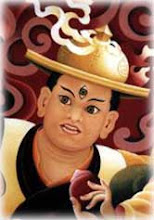Here are some extracts from the first chapter of the new Western Shugden Society book A Great Deception. This chapter concerns the problems that come from mixing religion and politics:
Lama Policy
The explanations given in this book are to encourage people not to follow or be influenced by 'Lama Policy', which like a drug causes people to be confused about the real nature of Buddhist practice. In this context, 'Lama' refers to the Fifth, Thirteenth and Fourteenth Dalai Lamas of Tibet. The policy of these lamas has been to use religion for political aims, thus causing suffering to millions of people from generation to generation. Because of the Fifth Dalai Lama's policy of mixing religion and politics, the Nyingma, Sakya and Kagyu traditions of Tibetan Buddhism rapidly declined and, as a result, for hundred of years, millions of people who followed these traditions experienced great difficulties. Today, some people from these traditions say that it was the followers of the Gelug tradition who caused their tradition to decline, but this is untrue. The Gelugpas themselves had no political power. It was the Fifth Dalai Lama who alone used his political power to destroy the development of these traditions, both spiritually and materially.
The Fifth Dalai Lama always showed two faces. One was that of a Nyingmapa and the other was that of a Gelugpa. In fact, he did not follow either tradition, but remained between them without ever finding a pure spiritual path. In this he was like the present Dalai Lama, the Fourteenth, who also shows two faces and likewise has never found a pure spiritual path.
There then follows an explanation of how the Fifth Dalai Lama achieved his political power with the support of the Mongols by waging war against the King of Tibet. Then there is an extensive section concerning the hypocrisy of the political lamas:
In their teachings, the Fifth and Thirteenth Dalai Lamas talked about compassion, but they behaved like dictators, creating so many problems for their society. This is also true of the present Dalai Lama. Despite this hypocrisy, many people because of their extreme religious view and blind faith still believe that these lamas are holy beings. In Tibetan society, anyone who has views and intentions that are different from those of the Dalai Lama is immediately accused of not being Tibetan; they are criticised, threatened and ostracised. This happened in the past and is happening to Dorje Shugden practitioners today. From this alone we can see that this Lama Policy continues to have a devastating effect on society. This problem cannot be solved unless the lama himself changes his own attitude.
The Fifth Dalai Lama was the founder of Lama Policy which he called 'the union of religion and politics'. The nature of Lama Policy is deceptive; its function is only to mislead people and to use religion for political aims. It is like a rainbow, which from the distance looks beautiful but upon closer examination is seen to be completely empty and hollow. The lamas who have principally upheld the policy established by the Fifth Dalai Lama are the Thirteenth and Fourteenth Dalai Lamas, and of these two the policy of the present Dalai Lama is the worst.
The chapter continues with a discussion of the murder of Lama Ngatrul Dragpa Gyaltsen (who was opposed to Lama Policy) by the Fifth Dalai Lama and his ministers out of jealousy and fear, and Ngatrul Gyaltsen's subsequent incarnation as Dorje Shugden. Because of his rivalry with Ngatrul Dragpa, initially the Fifth Dalai Lama was opposed to Dorje Shugden, but later he changed his view and developed faith in this Deity, even going as far as being the first to write a praise to Dorje Shugden and establishing the Trode Khangsar Temple in Lhasa. The point is made that, because of the change of heart of the Great Fifth, the Fourteenth Dalai Lama's claim to be following the Fifth Dalai Lama by rejecting Dorje Shugden is clearly a lie. It is revealed that his real intention in banning Dorje Shugden is to weaken the Gelugpa tradition so that he can become the supreme head of Tibetan Buddhism.
The chapter concludes with:
What the present Dalai Lama really wants is to become the leader of all traditions of Tibetan Buddhism by making all the practitioners of these traditions throughout the world follow only one tradition that he has newly created. Doing this would naturally destroy the pure lineage and blessings of the Nyingma, Sakya, Kagyu and Gelug traditions. This would be a very great loss to the world, when people more than ever need access to the Buddha's supreme methods of finding true peace and happiness, and it is for this reason that the Western Shugden Society is encouraging people to stop being deceived by the drug of Lama Policy.
How ironic it is that the Dalai Lama is whipping up hysteria around the supposed sectarian dangers of Dorje Shugden practice when, in actuality, it is his personal ambition for power that is the biggest threat to the continued existence of the four traditions of Tibetan Buddhism. It's like putting a wolf in charge of the sheep.





No comments:
Post a Comment